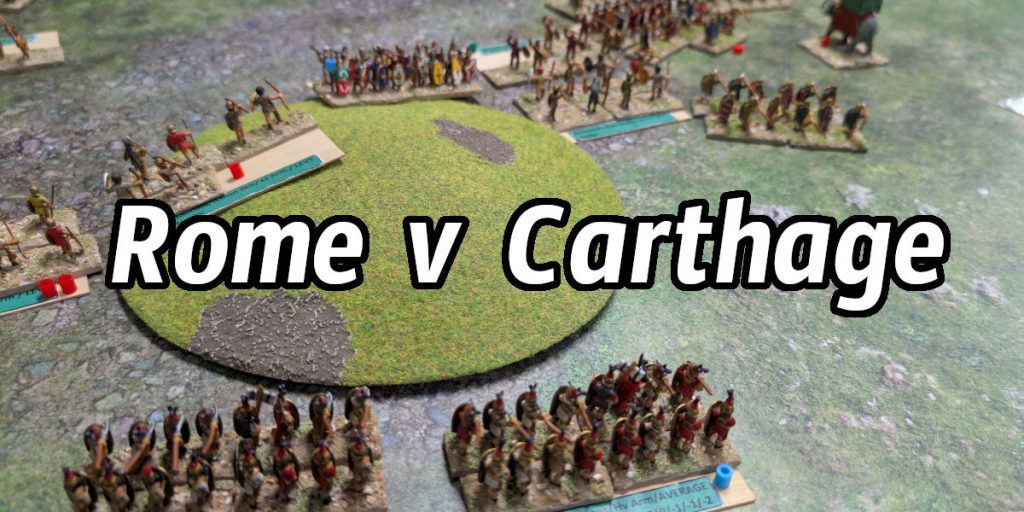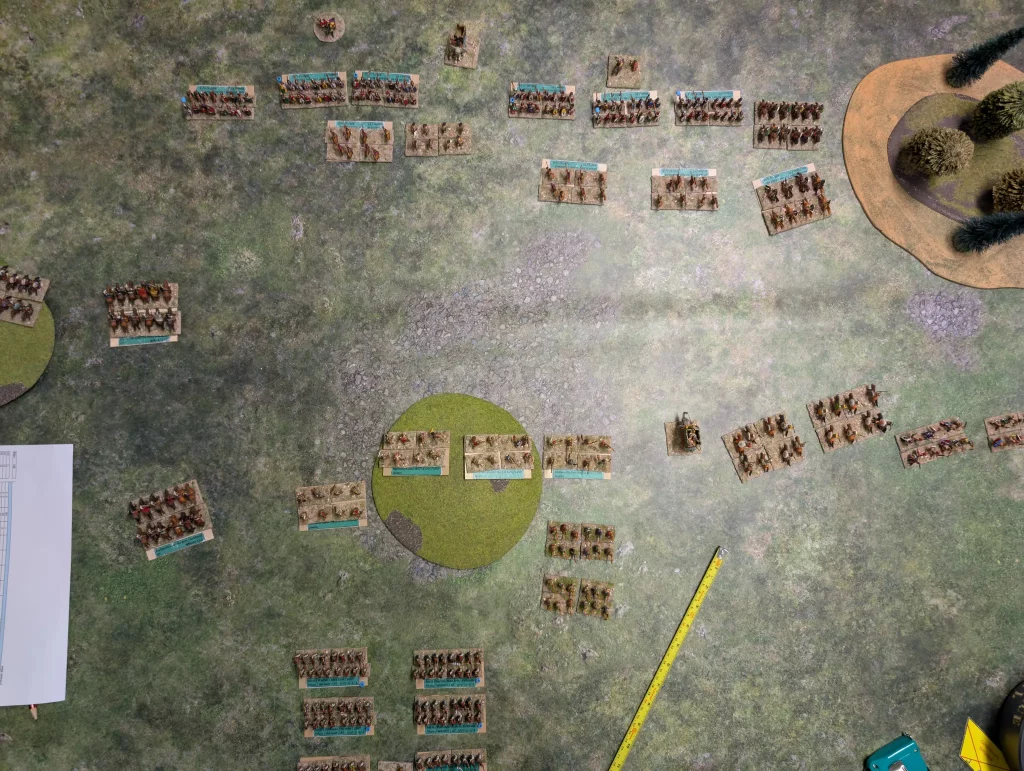When Elephants Go Berserk

This week’s wargaming at the club was a 15mm game of Romans v Carthaginians. It was two v two players, so some tactics had to be discussed before hand. The rules we were using were the club’s own, which I’ve played a couple of times before in the 28mm fantasy games, but not for a historical battle.


My initial plan, was for my left flank to try and go for their commander, who was sheltering behind some elite infantry. If the skirmish troops on our right flank could outflank around the woods, then it might force their flank to stay back and deal with them, whilst the heavy infantry on our centre pushed through.
Movement in this game was a lot faster than I’m used to. Cavalry move at 24″, which is twice what I’d expect in Saga or Lion’s Rampant. Carthage went first, and their cavalry quickly moved up to take the hill. I charged a unit of their light cavalry, who turned tail and fled – all the way back to their table edge – before combat could be joined. My second cavalry unit I kept in reserve, to protect my first.
Meanwhile, our Javelin infantry took the central hill, and the light troops on both sides moved in for a clash over on the right.

On turn two, I charged after their light cavalry, hitting them in the rear. They fled again before I could catch them – right off the table. However, in this game this doesn’t mean that a unit is lost – they just come back on later. Which was a surprise. However, it did mean I had a unit of heavy cavalry sitting behind their commander.
However, this isn’t a skirmish game, and is more like Warhammer1 where you have to wheel units around and worry about facing. So I couldn’t simply turn back and charge. By the time I was moved around, a unit of elite infantry and turned to face me. I intended to charge, but was told that this would be a very bad idea. Apparently these infantry are really strong against cavalry.
The game has a mechanism where there’s a look up table between different unit types. So some units might roll 1D6 for each ‘base’ in the unit, others might roll 2D6 or more. It’s not just a simple “this unit does X, and that’s it”. It changes depending on what you’re up against.

Meanwhile, our centre and right flanks were beginning to close, trading missile fire. We had an elephant charging forward, but it got shot and failed a berserk check. It turned around and fled backwards. Fortunately none of our units were in the way.

There wasn’t a lot going on on my side. A unit of Carthaginian cavalry held the hill on the left, and one of my cavalry units were facing off against them, but not attacking. Attacking up a hill is bad, so I didn’t want to do that. They didn’t want to lose their advantage by coming off the hill. But I had a cunning plan.

My main legions were still being mostly held back behind the central hill. I was gradually starting to move them forward, but was mostly keeping them in reserve – and also not wanting for them to get charged in the side by someone.

My first cavalry unit was now approaching the hill from behind, planning to attack the Carthaginians in their rear. My second unit was at the base of the hill daring them to attack, and preventing them from going anywhere.
They took the bait, and charged down. My second unit quickly came up and we had them sandwiched on the hill where we made short work of them.
Sorry, that was in a different reality. We had them sandwiched for several turns. Maybe four or five turns – pretty much the rest of the game – involved my two units trying to grind down the one unit.

Meanwhile, on the Roman’s right flank, we were taking casualties. Low quality units were falling to better trained and equipped units of Carthage. But Carthage had committed most of their forces by this point, and I still had two whole legions held mostly in reserve.

Finally, I decided to commit one legion, sending them up against the elite infantry of Carthage. I had three units against their one. I found out too late that my front line units had missile attacks, and my rear units didn’t. So the missile units got involved in melee, whilst the melee only units stood back and couldn’t support anyone.
Eventually, Carthage sent a unit of infantry up to the hill to attack my second cavalry unit in the rear, leading briefly to a four way battle which devolved into a two way battle.

We’d lost control of the central hill, with Carthage heavy infantry breaking through our ranks and up onto it. We mostly had skirmisher units holding it, so it wasn’t too surprising. But over the other side I had several units of fresh infantry.
As Carthage came over the hill and charged the Roman legionnaires, a brought other units around to outflank them. Even with two units sandwiching them, they held on fast.
On the second round of this, it was pointed out that I should be getting double attack dice since I was attacking them in the flank or rear. But shouldn’t that have meant I would have been getting double attack dice for the last five turns on the other hill? Apparently yes…

By now the hill on the left flank had been taken from Carthage, and I was finally getting units into a position where I could attack their commander.
We were taking back control of the central hill as well, and had several units that were mostly still fresh and unharmed. I was losing more bases than I’d have liked though – when you lose one base, you make a morale check to see if you lose a second, and I was bad at morale checks. And armour saves.

The Carthaginians also had an elephant of their own, which was charging towards what was left of the central ranks. I managed to get a few shots in against it, which drove it berserk. It charged forward – straight through all the ranks that were fighting.

The ending was messy. Carthage considered it a defeat, but Rome had taken a lot of casualties as well. If it continued, victory would probably go to Rome, since we still had several good quality fresh units. A fight to the death would be messy though.
It was a good game, though much more complicated than I’m used to. There are a lot of different unit types with small differences, and it’s not always clear what is what. The manoeuvring limitations can sometimes lead to decisions that feel like you’re just taking advantage of the rules, but maybe that’s because I don’t know them well enough. Having lots of units allows better use of keeping things in reserve. Since you can move all your units (unlike in Lion’s Rampant, or Saga), it’s a bit easier to do combined unit tactics as well.
Getting the rules wrong about flanking attacks was a bit annoying, but that’s how it goes when you’re not used to the rules. It was fun, which is the main thing. It’s also good to try other systems. It’s not one I intend to play a lot though. I don’t collect 15mm figures for one thing, and though I like the scale of the battles it can support, I do prefer more skirmish based rule systems.
- And yes, lots of other games as well. Warhammer is just the one like this I’ve played the most. ↩︎